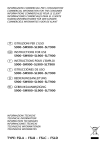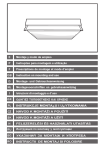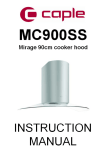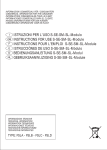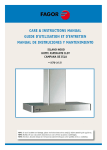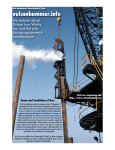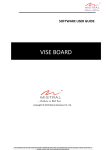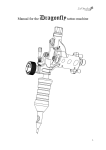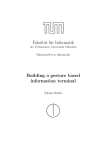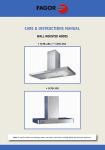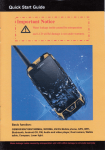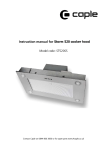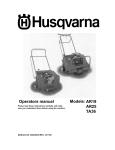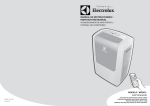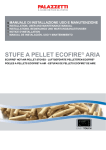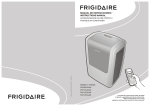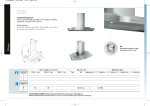Download ISTRUZIONI PER L`USO S901-S902 INSTRUCTIONS FOR USE
Transcript
INFORMAZIONI COMMERCIALI PER I CONSUMATORI COMMERCIAL INFORMATION FOR THE CONSUMER I GB ISTRUZIONI PER L'USO S901-S902 INSTRUCTIONS FOR USE S901-S902 INFORMAZIONI TECNICHE TECHNICAL INFORMATION TYPE: FSLC 1 I Il simbolo sul prodotto o sulla confezione indica che il prodotto non deve essere considerato come un normale rifiuto domestico, ma deve essere portato nel punto di raccolta appropriato per il riciclaggio di apparecchiature elettriche ed elettroniche. Provvedendo a smaltire questo prodotto in modo appropriato, si contribuisce a evitare potenziali conseguenze negative per l’ambiente e per la salute, che potrebbero derivare da uno smaltimento inadeguato del prodotto. Per informazioni più dettagliate sul riciclaggio di questo prodotto, contattare l’ufficio comunale, il servizio locale di smaltimento rifiuti o il negozio in cui è stato acquistato il prodotto. Questo elettrodomestico è marcato conformemente alla Direttiva Europea 2002/96/CE sui rifiuti da apparecchiature elettriche ed elettroniche (WEEE). GB The symbol on the product or on its packaging indicates that this product may not be treated as household waste. Instead it shall be handed over to the applicable collection point for the recycling of electrical and electronic equipment. By ensuring this product is disposed of correctly, you will help prevent potential negative consequences for the environment and human health, which could otherwise be caused by inappropriate waste handling of this product. For more detailed information about recycling of this product, please contact your local city office, your household waste disposal service or the shop where you purchased the product. This appliance is marked according to the European directive 2002/96/EC on waste electrical and electronic equipment (WEEE). 2 I INDICE Avvertenze Versioni d’uso Installazione Funzionamento Manutenzione 3 Se l'apparecchio è provvisto di cavo alimentazione e di spina, deve essere posto in modo che la spina sia facilmente accessibile. AVVERTENZE * Evitare l'uso di materiali che causano fiammate (flambè) nelle immediate vicinanze dell'apparecchio. Nel caso di fritture fare particolarmente attenzione al pericolo di incendio che costituiscono olio e grassi. Particolarmente pericoloso per la sua infiammabilità è l'olio già usato. Non usare griglie elettriche scoperte. Per evitare un possibile rischio di incendio attenersi alle istruzioni indicate per la pulizia dei filtri antigrasso e la rimozione di eventuali depositi di grasso sull'apparecchio. * La distanza minima tra la superficie del piano di cottura e la parte inferiore del la cappa deve essere 65 cm. * L'aria raccolta non deve essere convogliata in un condotto usato per lo scarico di fumi di apparecchi alimentati con energia diversa da quella elettrica (impianti di riscaldamento centralizzati, termosifoni, scaldabagni, ecc.). * Per lo scarico dell'aria da evacuare rispettare le prescrizioni delle autorità competenti. VERSIONI D’USO * Prevedere un'adeguata areazione del locale quando una cappa ed apparecchi alimentati con energia diversa da quella elettrica (stufe a gas, ad olio, a carbone, ecc.), vengono usati contemporaneamente. La cappa aspirante evacuando l'aria potrebbe creare una pressione negativa nella stanza. La pressione negativa del locale non deve superare i 0,04 mbar, evitando così il risucchio dei gas di scarico della fonte di calore. Pertanto bisogna attrezzare il locale con delle prese d'aria che alimentino un flusso costante di aria fresca. L'apparecchio è già predisposto sia per la versione filtrante sia per la versione aspirante. * Nella versione filtrante (dis.1) l'aria ed i vapori convogliati dall'apparecchio, vengono depurati sia da un filtro antigrasso sia da un filtro al carbone attivo e rimessi in circolazione nell'ambiente attraverso un foro praticato nella parte superiore del pensile. Quando l’etichetta dati tecnici interna alla cappa mostra il simbolo , l’apparecchio è in classe II°, quindi non necessita di collegamento a terra. * Nella versione aspirante (dis. 2) i vapori vengono convogliati direttamente all'esterno, tramite un condotto di evacuazione che si collega con la parte superiore della parete o del soffitto. L'utilizzo del filtro al carbone non è necessario. Quando l’etichetta dati tecnici interna alla cappa non mostra il simbolo , l’apparecchio è in classe I°, quindi necessita di collegamento a terra. INSTALLAZIONE * Nell'operazione di collegamento elettrico assicurarsi che la presa di corrente sia munita di collegamento a terra e verificare che i valori di tensione corrispondono con quelli indicati nella targhetta all'interno dell'apparecchio. Prima di procedere all'installazione, per evitare danni dell'apparecchio, disinserire i filtri antigrasso. La rimozione dei filtri metallici antigrasso avviene spingendo il filtro verso la parte posteriore della cappa e facendolo ruotare verso il basso sganciandolo dalla sua sede (dis.3). * Prima di procedere a qualsiasi operazione di pulizia o manutenzione è necessario togliere l'apparecchio dalla rete. Se l'apparecchio non è provvisto di cavo flessibile non separabile e di spina, o di altro dispositivo che assicuri la omnipolare disinserzione dalla rete, con una distanza di apertura dei contatti di almeno 3 mm, allora tali dispositivi di separazione dalla rete devono essere previsti nell'istallazione fissa. I requisiti essenziali prima di effettuare il montaggio dell’apparecchio sono: * Aver praticato l’apertura necessaria sul fondo del pensile giusta ad accogliere l’apparecchio (dis. 4 per S901, dis. 4A per S902). * Predisporre l’alimentazione elettrica. * Predisporre, sia in versione filtrante, sia in versione aspirante, il foro evacuazione aria. 4 Per istallare l’apparecchio regolare la posizione delle molle laterali di aggancio tramite le apposite viti (dis. 5), in rapporto allo spessore del pannello forato su cui andrà ancorato. Inserire il gruppo nella sede praticata nel pensile fino al completo bloccaggio delle molle laterali. Utilizzare le viti in dotazione per il definitivo bloccaggio tramite i fori interni dell’apparecchio (dis. 6). Ripristinare i filtri antigrasso. La pulizia del filtro antigrasso può essere eseguita a mano o in lavastoviglie. La pulizia avviene in rapporto all'uso, almeno una volta ogni due mesi. * Nel caso d'uso dell'apparecchio in versione filtrante, è necessario sostituire il filtro carbone attivo (dis.7) periodicamente. Il filtro ai carboni attivi si rimuove togliendo prima il filtro antigrasso (dis.3) e poi tirando l'apposita linguetta in plastica del filtro carbone sganciandolo dalla sua sede (dis.7). Il filtro al carbone viene inserito nell'operazione inversa. La sostituzione del filtro al carbone avviene in rapporto all'uso, almeno una volta ogni sei mesi. Bloccaggio valvola Attenzione! Prima di collegare il tubo flessibile uscita aria al motore, accertarsi che la valvola di non ritorno posta sulla bocca del motore sia libera di roteare. * Versione aspirante Collegare la flangia della cappa al foro di evacuazione tramite un tubo adatto. Effettuare il collegamento elettrico mediante il cavo alimentazione. * Rimozione serbatoio olio Dopo aver rimosso i filtri in acciaio ed eventualmente quelli ai carboni attivi, con una mano sorreggere il serbatoio olio e con l’altra allentare i pomelli come indicato in fig.8, far scorrere quindi il serbatoio verso il basso facendo attenzione a non versare l’olio. * Versione filtrante Collegare alla flangia un tubo adatto che convogli l’aria fino alla parte superiore del pensile. Effettuare il collegamento elettrico mediante il cavo alimentazione. * Per la pulizia dell'apparecchio stesso viene consigliato l'uso di acqua tiepida e detersivo neutro, evitando l'uso di prodotti contenenti abrasivi. Per la pulizia di apparecchi in acciaio viene consigliato l'uso di prodotti specializzati, seguendo le istruzioni indicate sul prodotto. FUNZIONAMENTO Att. nel caso di smontaggio dell’apparecchio dal pensile svitare le viti di fissaggio definitivo (dis. 6), togliere i filtri antigrasso (dis. 3), se ci sono i filtri ai carboni attivi (dis. 7) e agire sulla maniglietta delle molle poste internamente al gruppo con la forza necessaria a sganciare l’apparecchio dal pensile. Mod. S901-S902 (dis. 10) A: Interruttore on/off luce B: Interruttore on (I velocità)/off motore C: Interruttore II velocità D: Interruttore III velocità E: Interruttore IV velocità F: Temporizzatore 10 minuti * La sostituzione del cavo alimentazione deve essere eseguita esclusivamente da personale autorizzato. * Per sostituire la lampada dicroica, sfilare la lampada (dis.9) inserendo un piccolo giravite o un qualsiasi utensile appuntito tra lampada e il suo supporto cromato, e sostituire con una lampada delle stesse caratteristiche. MANUTENZIONE * Un'accurata manutenzione garantisce un buon funzionamento ed un buon rendimento nel tempo. * Una cura particolare va rivolta al pannello antigrasso. La rimozione del filtro avviene spingendolo verso la parte posteriore della cappa e facendo ruotare il filtro verso il basso sganciandolo dalla sua sede (dis.3). Il filtro viene inserito nell'operazione inversa. Dopo 30 ore di esercizio della cappa la pulsantiera, segnalerà la saturazione del filtro, mediante l'illuminazione di tutti i tasti. Per il reset, schiacciare il tasto temporizzatore . 5 GB CONTENTS Warnings Uses Installation Working Maintenance 6 * The use of materials which can burst into flames should be avoided in close proximity of the appliance. When frying, please pay particular attention to fire risk due to oil grease. Being highly inflammable, fried oil is especially dangerous. Do not use uncovered electric grills. In order to avoid possible fire risk, all instructions for grase-filter cleaning and for removing eventual grease deposits should be strictly followed. WARNINGS * The cooker surface and the inferior part of the cooker hood must be at a minimun distance of 65 cm. * The air sucked can't be conveyed through or into a duct used to let out fumes from appliances fed by energy other than electric power (eg. centralized heating, radiators, water-heaters, etc.). USES * To evacuate the air outlet, please comply with the pertaining rules given by competent authorities. The appliance is already arranged both for filtering and for suction performances. * Provide the room with an adequate aeration when a cooker hood and appliances fed by energy other than electric power (gas-, oil-, or coal- stoves, etc.) are used simultaneously. The cooker hood, when evacuating the sucked air, could generate a negative pressure in the room- which can't exceed the limit of 0.04 mbar, in order to avoid the suck of exhausts deriving from the heat-source. Therefore the room should be provided with air-intakes to allow a costant flow of fresh air. * In its filtering version (Fig.1), the air and fumes conveyed by the appliance are depured both by a grease filter and by an active coal filter, and put again into circulation through the hole made on the top of the cabinet. * In its sucking version (Fig.2), fumes are directly conveyed outside, through an evacuation duct connected with the superior part of the wall or the ceiling. Both coal filter and air deflector are not necessary in this case. If the rating lable in the cooker-hood shows the symbol , the appliance is built in class II° and it does not need any earth connection. INSTALLATION If the rating lable in the cooker-hood does not show the symbol , the appliance is built in class I° and it needs the earth connection. * Before installing the appliance, in order not to damage the appliance itself, the metal grase filter should be removed. These filter could be removed by pushing the handles towards the back side of the cooker hood and turning it downwards to unfasten it from its slot. (Fig.3). * When performing the electrical connections on the appliance, please make sure that the current-tap is provided with earth connection and that voltage values correspond to those indicated on the label placed inside the appliance itself. Essential precautions to respect before installing the appliance are the following: To have made a cut-out on the bottom of the cabinet which is suitable to hold the appliance in position (fig.4 for S901, fig. 4A for S902). * prepare the power supply. * prepare a hole for the exhaust of the air both in the filtering and in the exhauting version. * Before carrying out any cleaning or maintaining operations, the appliance needs to be removed from the electric grid. If the appliance is not provided with a non-separable flexible cable and plug, or with another device ensuring omnipolar disconnections from the grid, with an opening distance between the contacts of at least 3 mm, then such disconnecting devices must be supplied within the fixed installation. If the fixed appliance is endowed with a supply cord and a plug, the appliance has to be put in a place where the plug can be reached easily. 7 To install the appliance, adjust the position of the stop side-springs using the appropriate screws (fig.5), according to the thickness of the board previously drilled, on which the appliance will be fixed. Insert the built-in unit in the hole made in the cabinet until the stop click of the side- springs is heard and the built-in unit is blocked.Insert the screws provided in the holes inside the appliance (fig.6) to block it completely. Put the grease filter again The coal filter needs replacing depending on the use, but however every six months at least. Blocking of the stop valve * How to remove the oil tank. After having removed the grease filters and eventually the active coal filters, please hold the oil tank up by one hand and ioosen the three handles by the other hand as showed in fig.8. Then let the tank slide downwards making attention in order to avoid the leak of oil. Warning! Before connecting the flexible exhausting pipe to the motor, make sure the stop valve, which is on the air outlet of the motor, can swing. Exausting version Connect the flange to the exhausting hole with an appropriate pipe. Connect the appliance with the electrical mains through the supply cord. * To clean the appliance itself tepid water and neutral detergent are recommended, while abrasive products should be avoided. For steel appliances specialized detergents are recommended (please follow the instructions indicated o the product itself to obtain the desired results). Filtering version Connect the flange with a pipe suitable to convey the air to the top of the cabinet. Connect the appliance with the electrical mains through the supply cord. * Warning! To take down the appliance from the cabinet, remove the definitive fixing screws (fig. 6) using a screw-driver, get off the grease filters (fig.3) and the active carbon filters, if they are inserted (fig. 7). Act on the small handle of the springs, which are inside the built-in unit, with the necessary strength to unhook the appliance from the cabinet. WORKING Mod. S901-S902 (fig. 10) A: Light switch on/off B: Motor switch on speed 1/off C: Motor switch on speed 2 D: Motor switch on speed 3 E: Motor switch on speed 4 F: 10-minutes timer * If the supply cord is damaged, it must be replaced by the manufacturer or its sevice agent or a similarly qualified person in order to avoid a hazard. To replace the dichroic lamp, remove the lamp (fig.9) by inserting a screwdriver or another sharp too between the lamp and its chrom support and replace it with a l’appareil lamp of the same kind. MAINTENANCE * An accurate maintenance guarantees good functioning and long-lasting performance. * Particular care is due to the grease filter panel. It can be removed by pushing its special handle toward the back-side of the cooker hood and turning the filter downwards so to unfasten it from its slot (Fig.3). To insert the filter just perform the opposite operation. After 30 hours working, the push button control panel will signal the saturation of the grease filter by lighting all the buttons. Press the timer button to reset . The grease filter needs cleaning by regular handwashing or in dishwashers every two months at least or depending on its use. * In case the appliance is used in its filtering version, the active coal filter (Fig.7) needs to be periodically replaced. The coal filter can be removed by removing the grease filter first (Fig.3), and by pulling its special plastic tongue until it is unfastened from its slot. Reinsert the coal filter by operating in the opposite way. 8 1 2 3 4 4/A 9 5 6 7 8 9 10 10 90001100020 - 12/06 11












